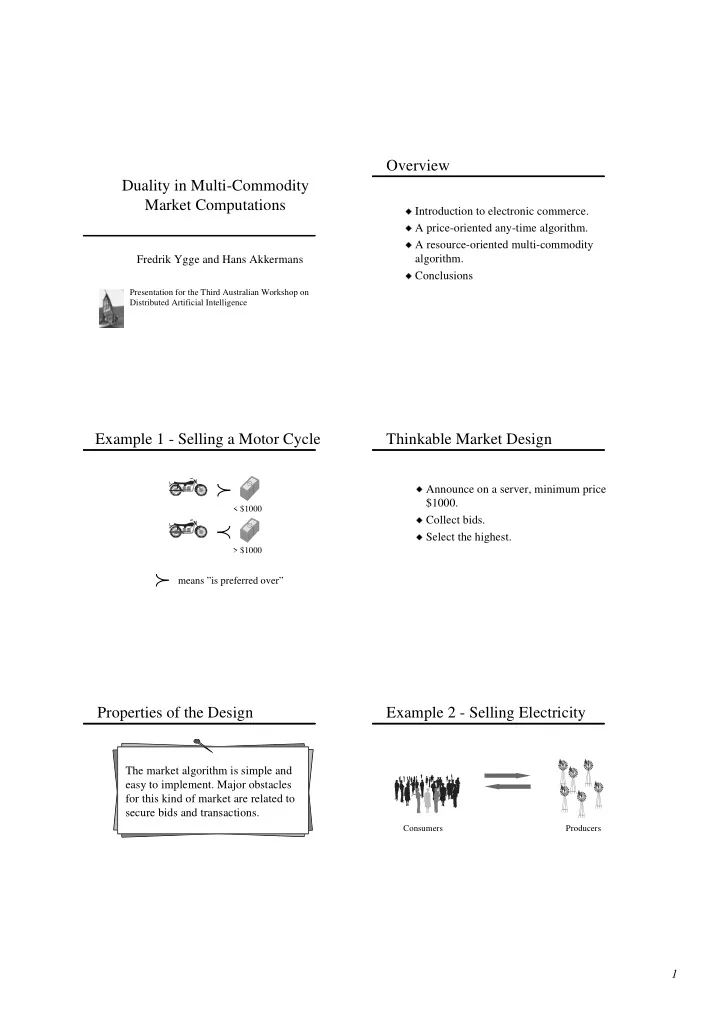

Overview Duality in Multi-Commodity Market Computations u Introduction to electronic commerce. u A price-oriented any-time algorithm. u A resource-oriented multi-commodity algorithm. Fredrik Ygge and Hans Akkermans u Conclusions Presentation for the Third Australian Workshop on Distributed Artificial Intelligence Example 1 - Selling a Motor Cycle Thinkable Market Design � u Announce on a server, minimum price $1000. < $1000 u Collect bids. � u Select the highest. > $1000 � means ”is preferred over” Properties of the Design Example 2 - Selling Electricity The market algorithm is simple and easy to implement. Major obstacles for this kind of market are related to secure bids and transactions. Consumers Producers 1
Consumer Preferences Consumer Preferences (cont.) The consumer preferences are modeled as utility functions . → ( ) ( ) 200W 18C � $0.1 > ⇔ , , u r m u r m 1 1 2 2 → 210W 19C � $0.15 r m , r , m f → 1 1 2 2 240W 20C $0.20 � → 280W 21C $0.15 From the utility function one can compute: � • a demand, i.e. how much a consumer is willing to buy at and everything in between, different prices, and • a price for which the consumer is willing to by an e.g., 217.3987W, i.e. an additional (small) amount of resource at the current infinite number of points. allocation. Producer Preferences Market Design ? The preferences of the producer are modeled by max p x r - cost(r), i.e. it maximizes its profits given the costs for production. Consumers Producers From this one can compute both the supply and the price as in the case of a consumer. Problem Suggestion 1- A Price-Oriented Approach Auctioneer Supply Demand The resource can not be reallocated Price as long as there is a mismatch between supply and demand, and Update price until supply there might be time constraints. meets demand (W ALRAS , Newton methods). With many consumers and producers, they will typically reveal their true preferences Consumers Producers (Sandholm and Ygge, IJCAI, 1997). 2
Contribution 1 of the paper P ROPORTION - Basic Principles 8 Excess demand: 6. Total demand: 16. 6 An algorithm that produces feasable Total supply: 10. 4 allocations from intermediate prices, also Demand 2 Demand Allocate what is demanded Allocation 0 for the case of multi-commodity markets. to all agents holding a -2 negative demand, and (This presentation has, for simplicity, only allocate 10/16 times their -4 demands to all agents been on two commodities, electricity and -6 having a positive demand. money.) P ROPORTION - Outcome Quality Suggestion 2 - A Resource-Oriented Approach Auctioneer 0,35 For obtaining a good approximation of the equilibrium Price Price 0,3 in the analyzed examples, 85 iterations are typically required. 0,25 Allocation After applying P ROPORTION after Relative utility 0,2 5 iterations and 99.47% of the average utility improvement is 0,15 obtained. For 10 iterations the Update allocations until number is 99.96%. The total 0,1 every agent is willing to pay excess demand is smaller after the same price for an 0,05 having applied P ROPORTION after additional small amount of 5 iterations than after 85 iterations resource. 0 Consumers Producers 0 1 2 3 4 5 6 7 8 9 10 without P ROPORTION . Applicable to a wide class Nr of iterations (but not to all) of market configurations. Contribution 2 - A Resource-Oriented Algorithm for the Multi-Commodity Case Advantages of the Resource-Oriented Algorithm u At each step of the algorithm, feasable ( ) − ( ) ( ) allocations are obtained. ( ) ( ) 1 ( ) ( ) ( ) ( ) ( ) ( ) ( ) n − ( ) n − ( ) − 1 ∑ 1 − ∑ 1 + = − ⋅ ∇ − − ∇ ∇ ∇ 1 ∇ − i 1 i i i i i i i i i i z z s p z p z p z p z p z p z p z p z p z α α α α α α β β β β β β n n n n n n n n β = β = 1 1 u The computation of the price functions is significantly easier than the computation of This is not as bad as it looks! It is actually quite easy to implement and a C++ implementation is available on the web. the demand from the utility functions etc. Furthermore, for a wide class of problems the above formula can presented above. be reduced to: u The algorithm has excellent converegence − ( ( ) ) 1 ( ( ) ) ( ) ( ( ) ) ( ) − ∑ n − 1 ∑ n − 1 + 1 i 1 = i − ⋅ ∇ i i − ∇ i ∇ i i z z s p z p z p z p z p z α α α α α α β β β β β β properties. β = β = 1 1 (The latter result is not part of the presented paper, but is contained in a submitted paper.) 3
Conclusions u In computational markets with continuous resources, price-oriented and resource-oriented approaches are conceivable. u We argued for the duality between price- oriented and resource-oriented and introduced: – a novel algorithm to produce feasable allocations from intermediate prices, and – a novel resource-oriented algorithm suitable also for the multi-commodity case. 4
Recommend
More recommend